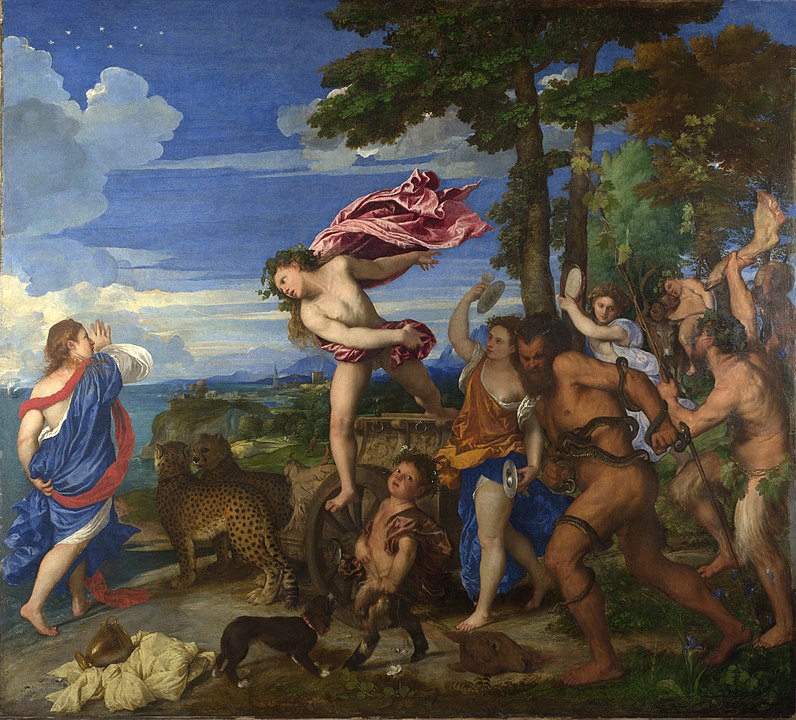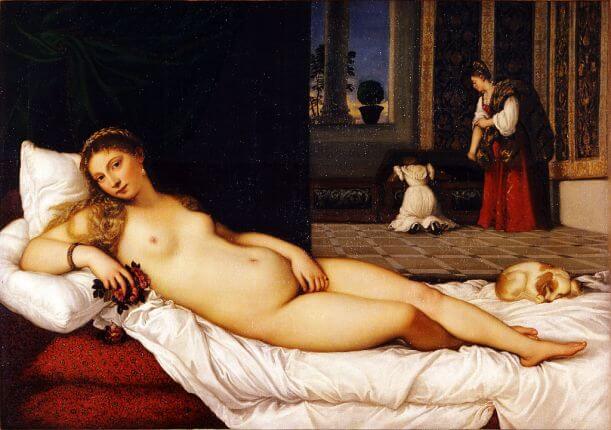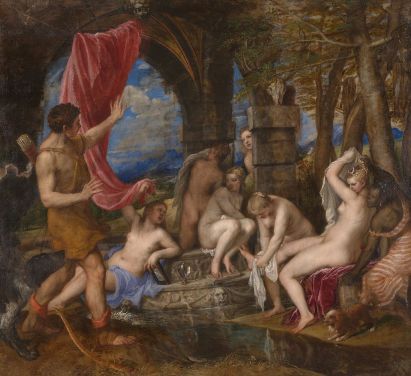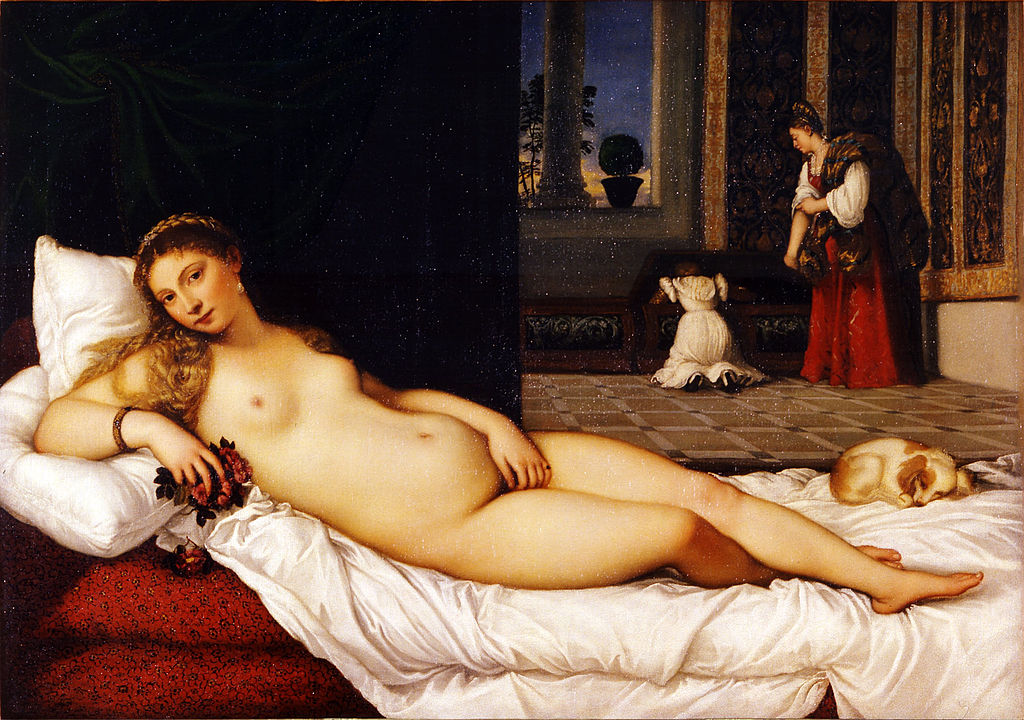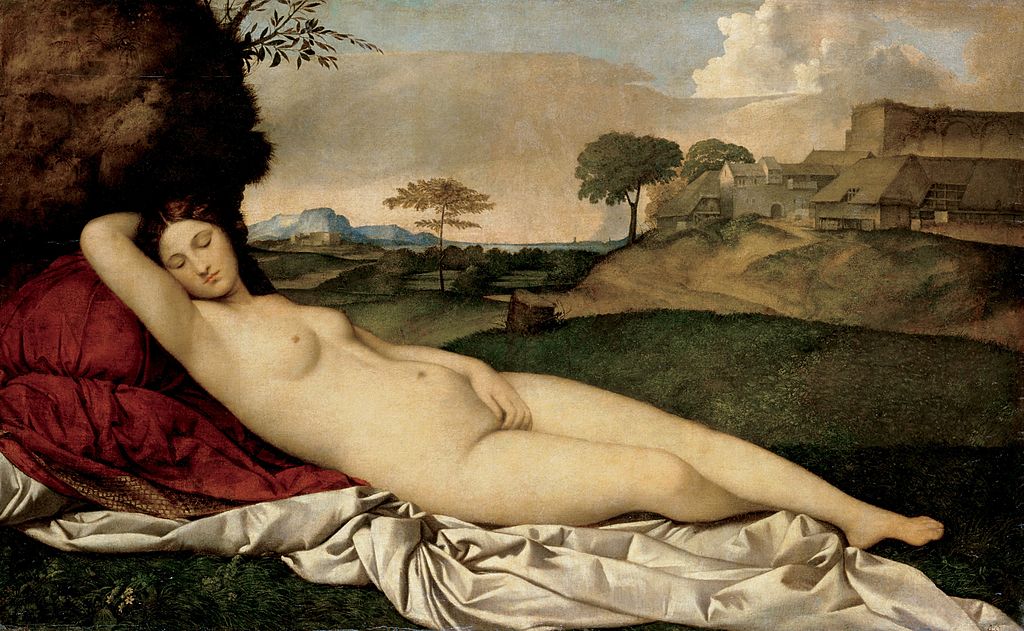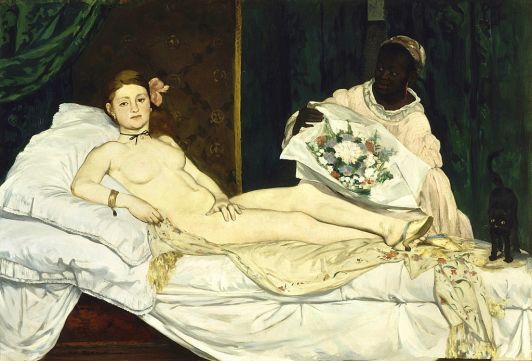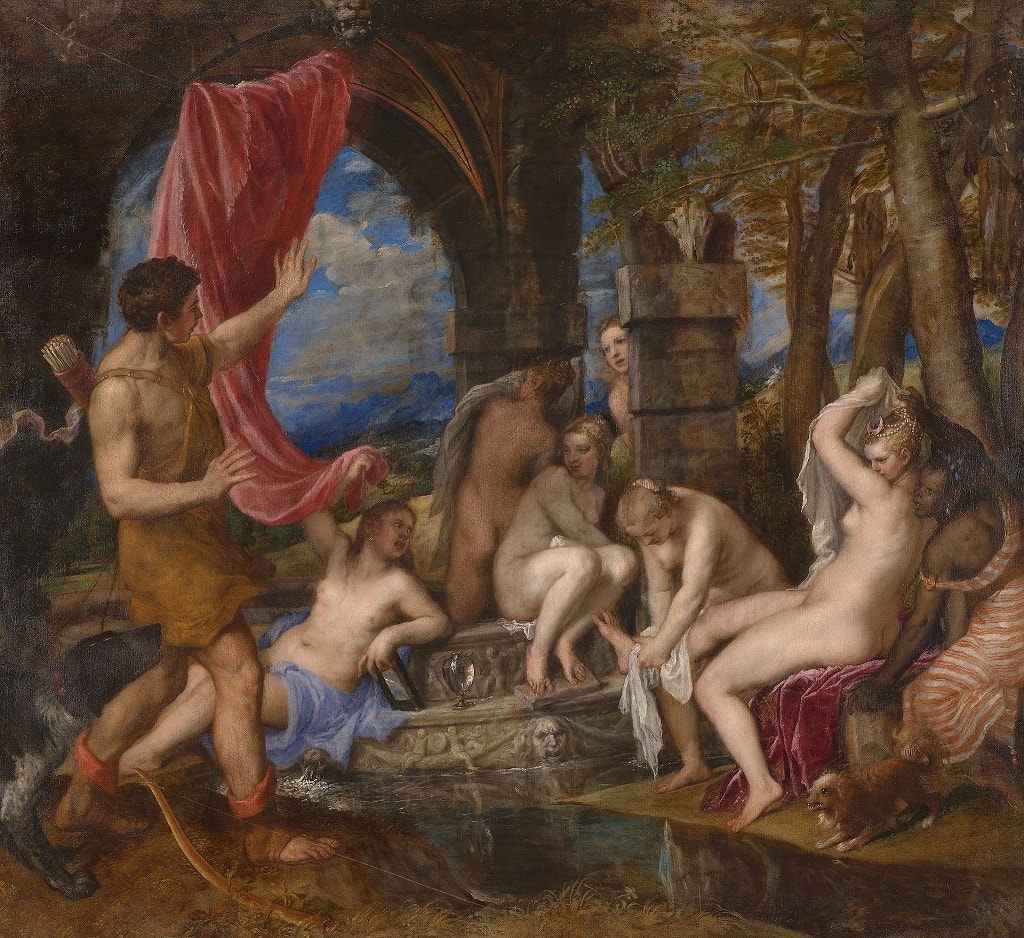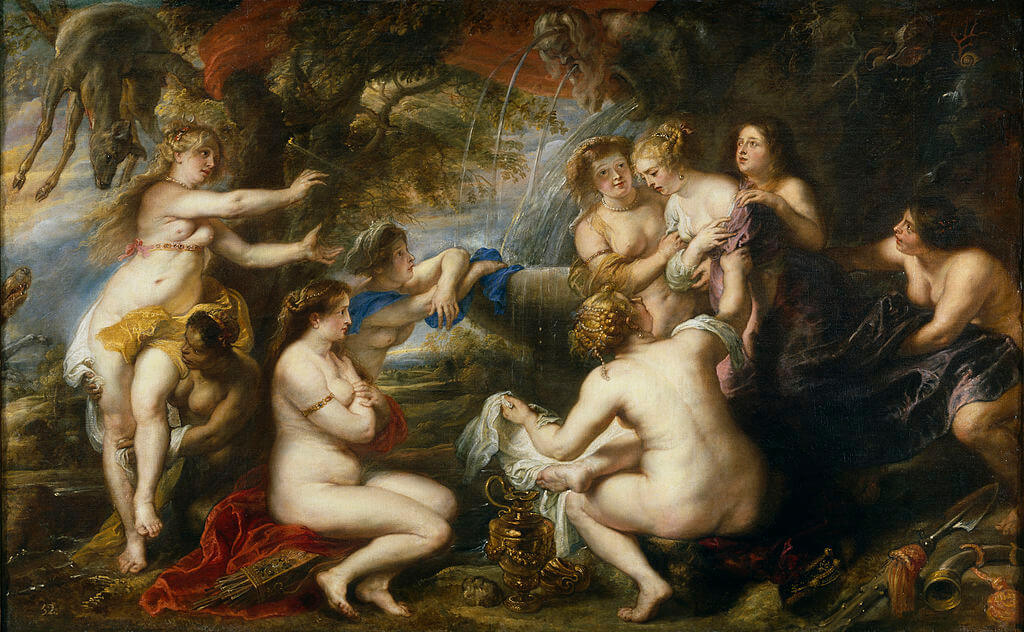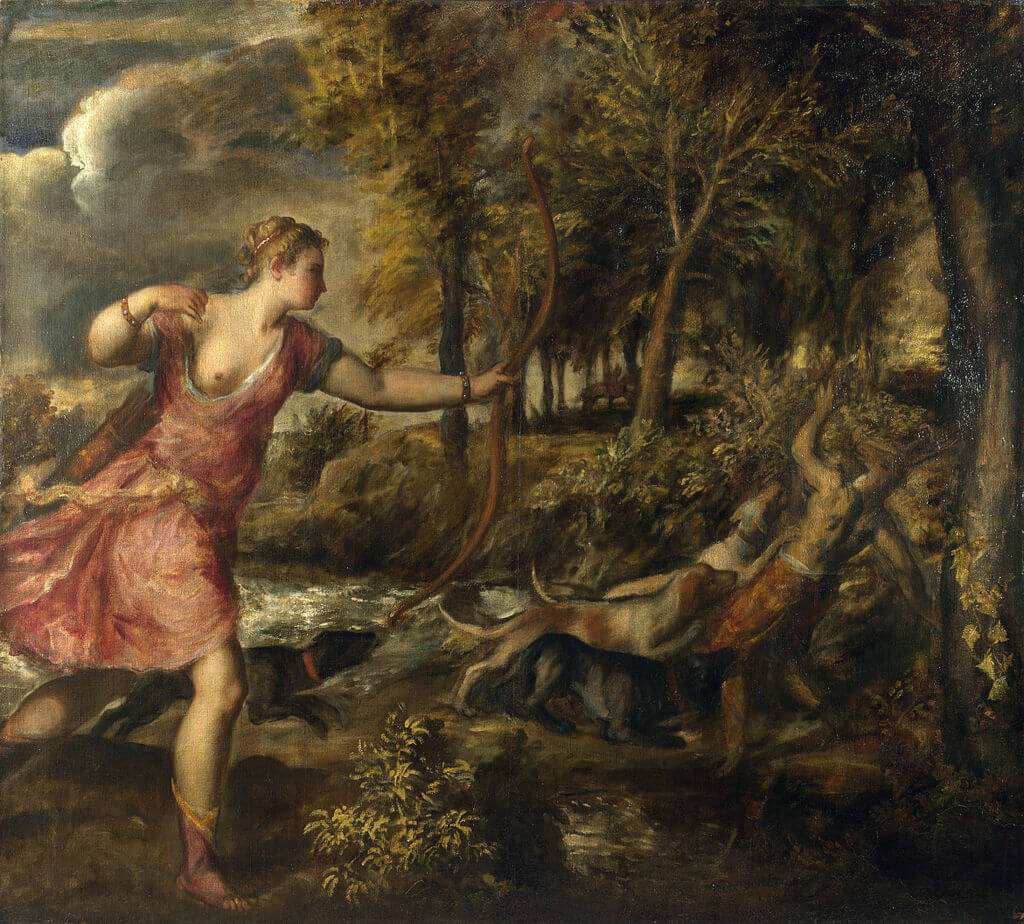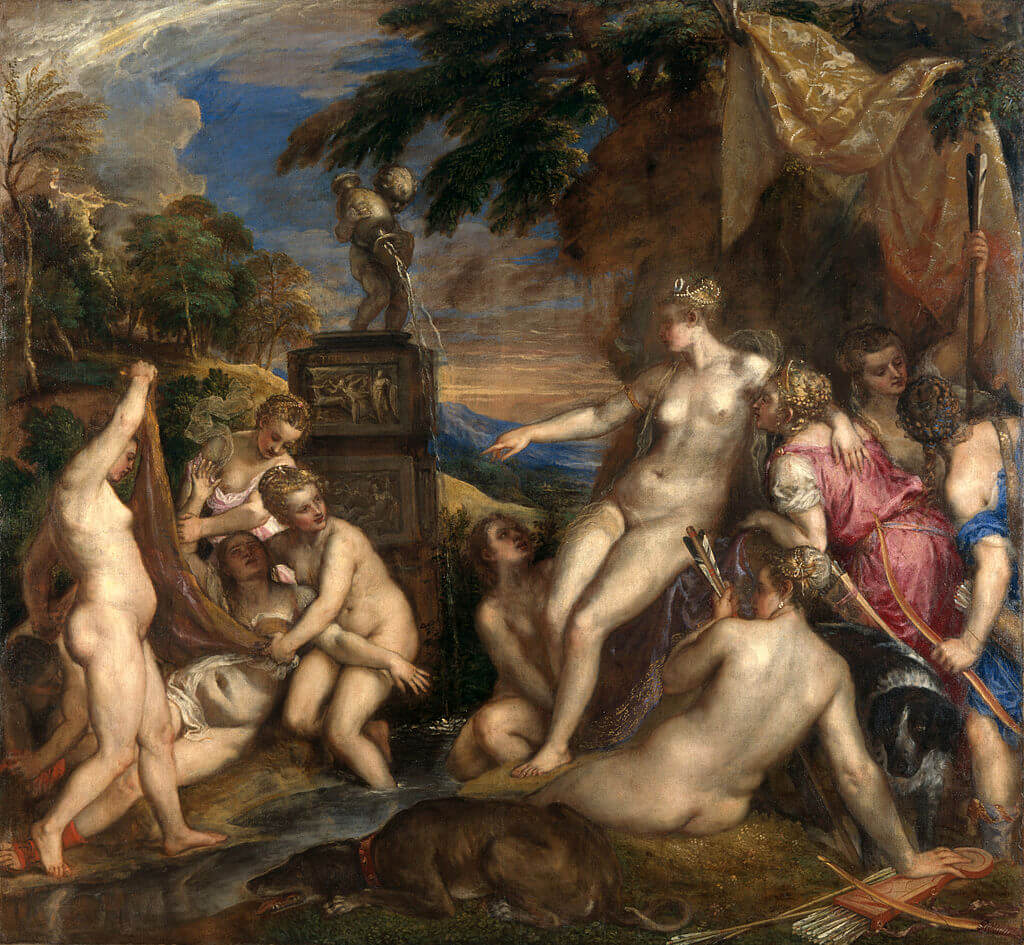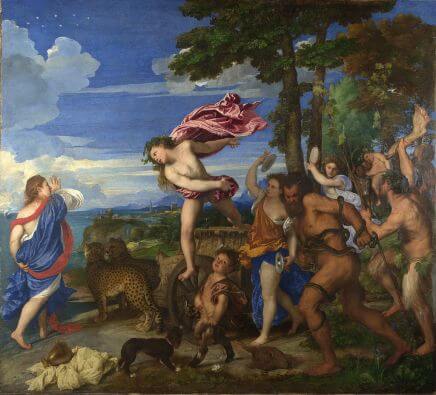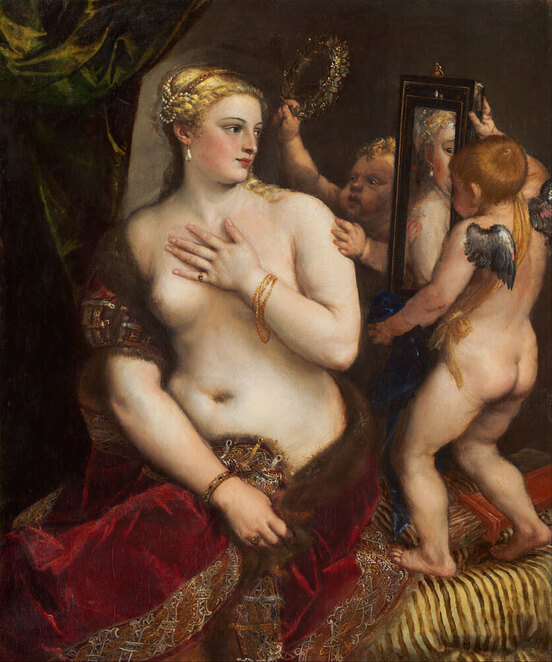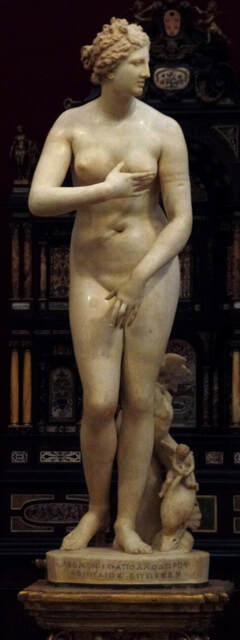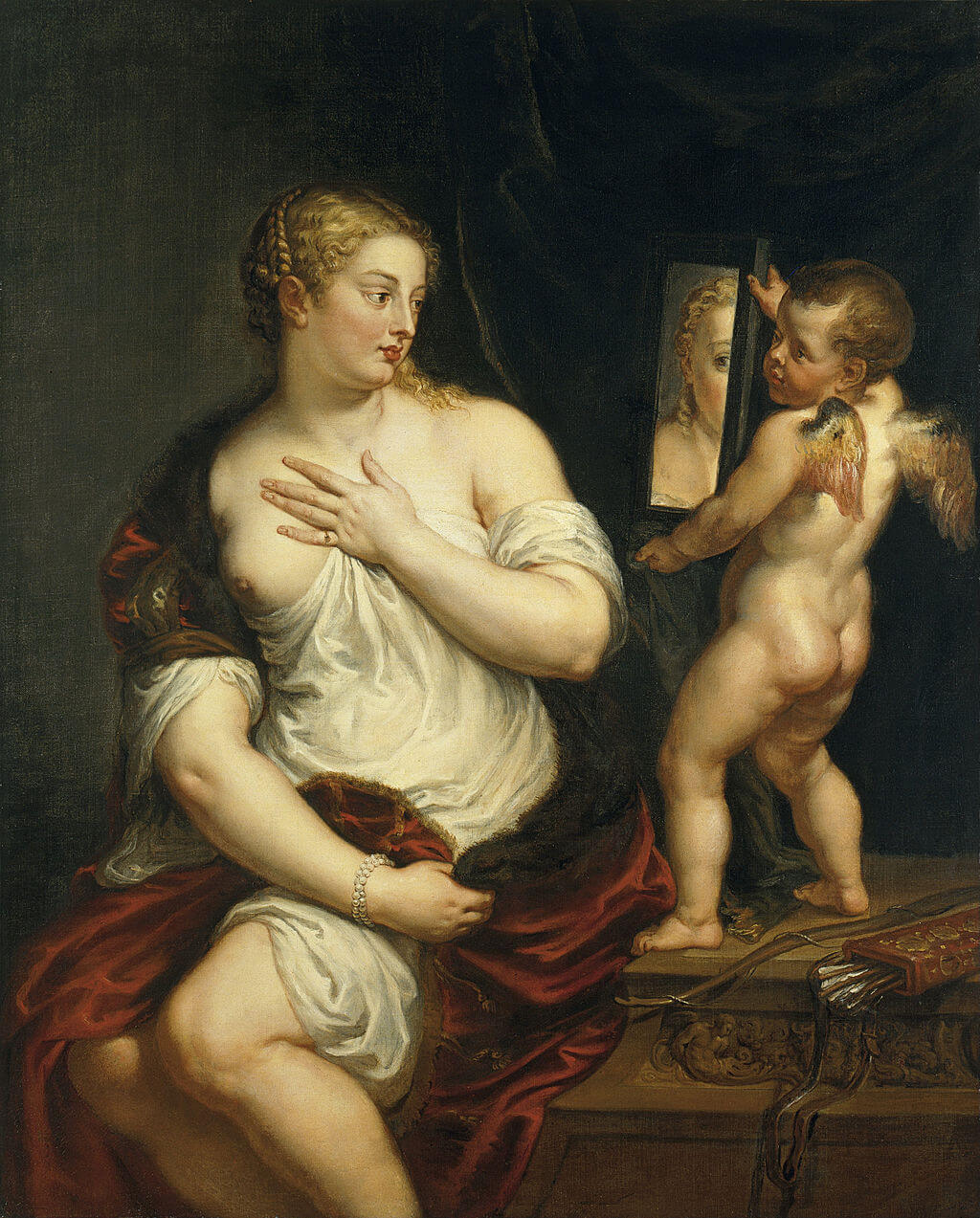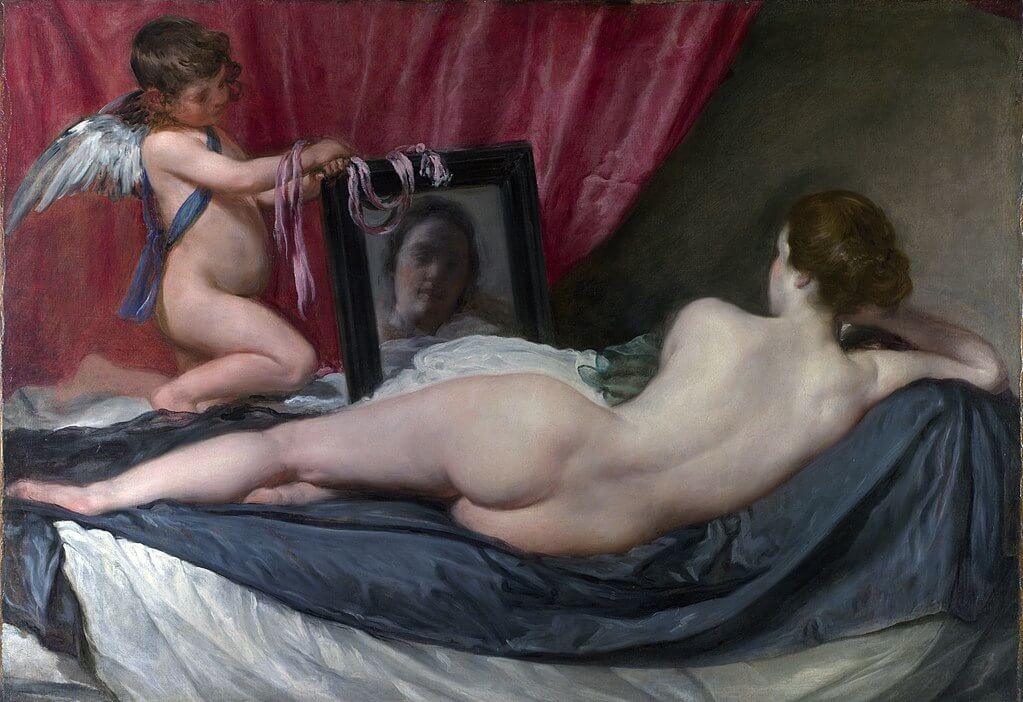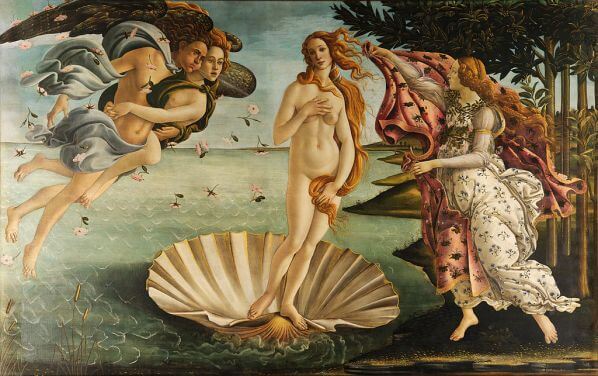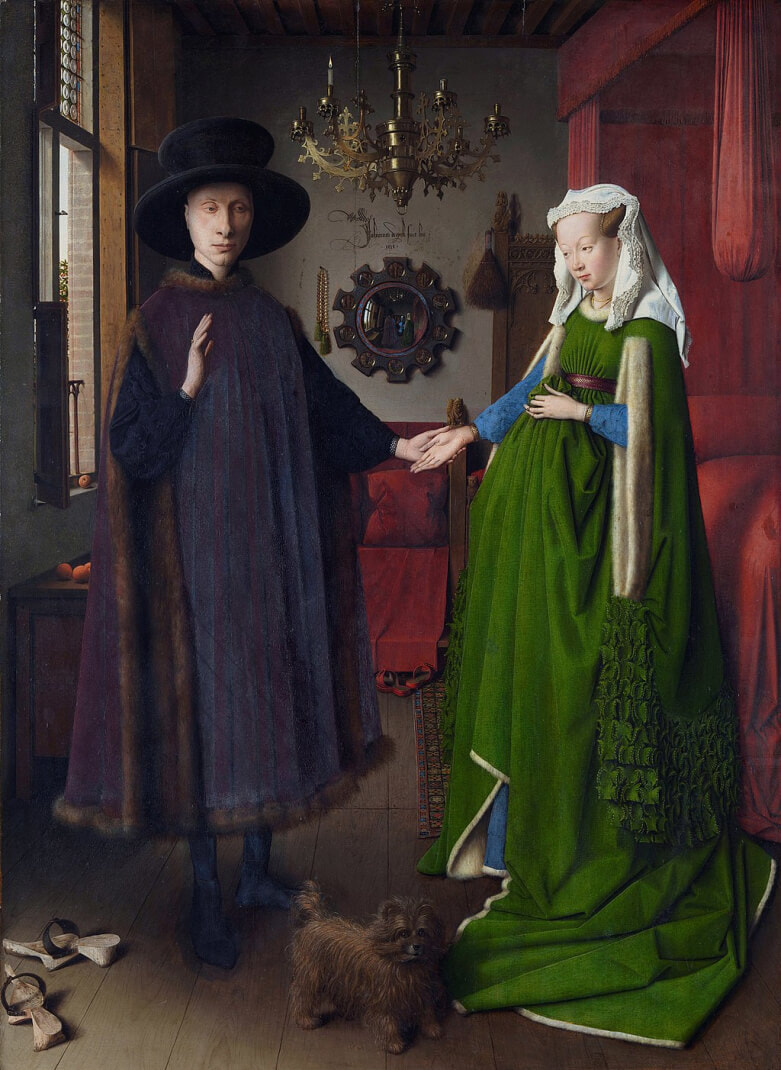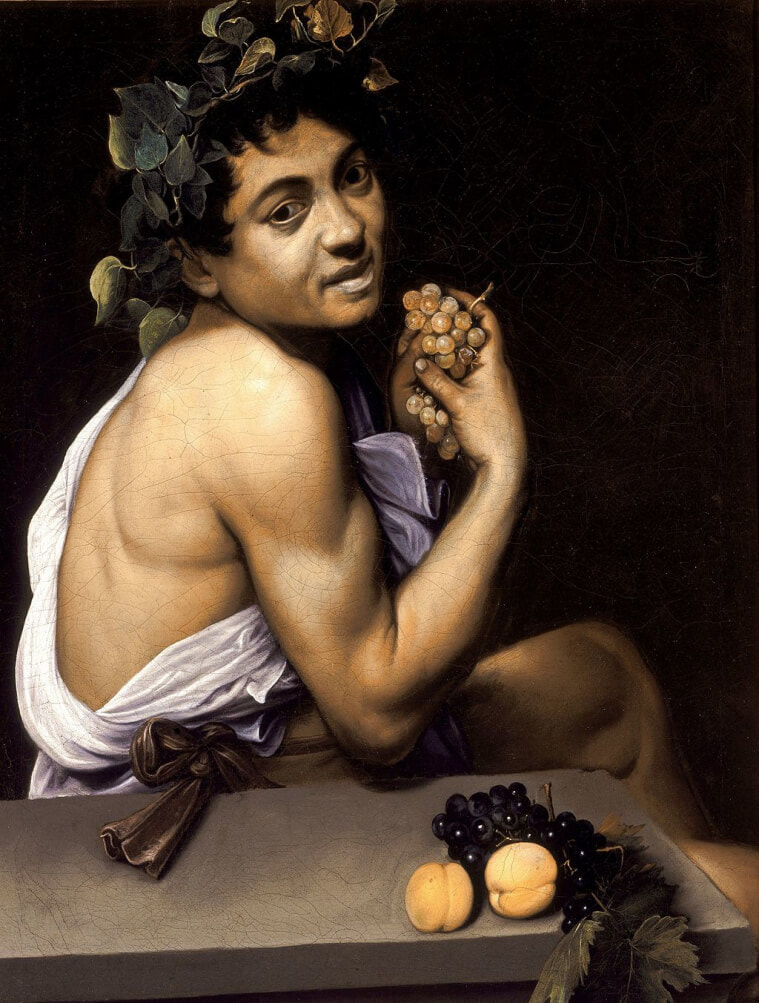|
Where? Room 2 of the National Gallery
When? 1522-1523 Commissioned by? Alfonso d’Este, the Duke of Ferrara, to decorate one of the rooms in his Ducal Palace. What do you see? On the left is Ariadne in a blue dress. She is left behind by Theseus on an island. You can still see the ship of Theseus near the horizon in the middle left of the painting. An almost naked Bacchus is jumping out of his chariot, which is carried by two cheetahs. Bacchus is immediately in love with Ariadne, but Ariadne seems hesitant as she is still dealing with the fact that Theseus left. While her arms and body are still in the direction of the ship of Theseus, her head is turned to Bacchus. Bacchus convinces Ariadne to marry him. Bacchus promises Ariadne to turn the diadem that Ariadne was wearing during their wedding into a constellation of stars, which you can see in the top left of the painting. Bacchus has also brought his entourage of drunk and crazy people on the right. One of his followers is holding the leg with a hoof of a cow that he just ripped off. You can see the head of the cow in the foreground, which is dragged along by a young boy. Completely on the right is a man carrying a barrel of wine and in the foreground, a man is trying to break free from snakes. Backstory: Alfonse d’Este originally commissioned Raphael and Fra Bartolommeu to make this painting but both died before they could start their work. He then decided to give the work to Titian. This painting is based on the mythological stories of the Latin poets Catullus and Ovid. The story is about Princess Ariadne from the Greek island of Crete. She fell in love with Theseus from Athens and helped him to kill the Minotaur. They left together from Crete, but Theseus abandoned her while she was asleep on the Greek island of Naxos. Ariadne was heartbroken when she discovered that Theseus had left and ran along the beach of Naxos to see if she could see any signs of him. At that moment, Bacchus - the god the wine, fertility, madness, theatre, and religious ecstasy - arrived. Bacchus had fallen in love with Ariadne and asked her to marry him. The painting is famous because Titian is able to paint a moment that is frozen in time in a very energetic scene. Notice also the beautiful use of bright color, typical for the School of Venice, which makes this painting come alive.
Symbolism: Bacchus is wearing a crown of ivy leafs, which is the sacred plant to Bacchus to prevent intoxication (which is what people in the past believed that ivy could do). The constellation of stars (which we now refer to as Corona Borealis) on the top left is in the form of the diadem that Ariadne was wearing when she married to Bacchus. It is a symbol of their marriage.
The wine barrel, tambourines, and snakes are all symbols of the lifestyle that Bacchus represents. The cheetahs refer to the collection of wild animals of the commissioner of this painting. Who is Ariadne? According to Greek mythology, Ariadne was the daughter of Minos, who was the King of Crete. Minos had built a labyrinth, with in the center a Minotaur (a creature with the head of a bull and the body of a human). He put his daughter Ariadne in charge of the labyrinth. Following an earlier dispute with Athens, every seven to nine years, 14 noble citizens from Athens were sacrificed to the Minotaur. One year, Theseus, was among these 14 noble citizens. Theseus became a hero as he killed the Minotaur, but to do that, he received help from Ariadne who was in love with him. Ariadne married in the end to Bacchus and gave him about 12 children. After Ariadne died, Bacchus brought her back from the underworld Hades and she became a Greek goddess. Why Bacchus? Bacchus was a chronic alcoholic, which made him a great subject for mythological stories and also for artworks. Bacchus was also the inspiration for popular festivals, called Bacchanalia, which were introduced to Rome in the second century before Christ. These festivals contained a lot of alcohol and nudity and were a popular theme in Renaissance art. Who is Titian? Titian (c. 1489 – 1576) was a painter and greatest member of the Venetian school of painters. He was very talented in painting both portraits and landscapes, which is and was a rare combination. In his teenage years, the Bellini brothers (Gentile and Giovanni) taught him how to paint, but his work was quickly considered to be better than that of the Bellini brothers. Some well-known paintings by Titian are his Venus of Urbino in the Uffizi Museum and Diana and Actaeon which is also in the National Gallery in London.
Fun fact: In the original story on Ariadne and Bacchus, the chariot of Bacchus was drawn by tigers. Instead, Titian painted two cheetahs. This was most likely the case, because Duke Alfonso d’Este did not have tigers, but did have cheetahs, in his menagerie.
Collecting wild and exotic animals, called a menagerie, was an impressive way to show off to your guests. Menageries of that time included animals like panthers, leopards, and elephants. Interested in a copy for yourself? Poster or canvas
0 Comments
Where? Room 83 of the Uffizi Museum
When? 1538 Commissioned by? Guidobaldo II Della Rovere (1514-1574), the Duke of Urbino (a sovereign of central-northern Italy), commissioned this oil painting for his wife, Giulia Varano (1523-1547). What do you see? A representation of a beautiful and sensual Venus, the goddess of love, is looking you straight in the eye. She lies naked on top of a white sheet in a room of a big Renaissance palace. Notice the beautifully painted folds in the sheets and the pillows. Venus is only wearing a gold bracelet with black enamels on her right arm, a ring on the pinky of her left hand, and a pearl earring. Venus has roses in her right hand, and you can see that one of the roses has already fallen on the red bed which has a pattern of black flowers. Her hair, partly woven in braids, is falling over her shoulders. Her body is contrasted with the dark background on the left, emphasizing her nakedness. Notice how the straight lines of the architecture nicely contrast with the curviness of Venus. The two maids in the background are apparently searching for Venus’ clothes in one of the two bridal chests. Backstory: Guidobaldo II Della Rovere gave this painting to his young wife (who was 15 at the time of the painting), and the painting provides the meaning of marriage. Some people consider this as one of the most erotic paintings in history. But others have a less flattering opinion. The American author Mark Twain described the work as follows in 1880: “The foulest, the vilest, the most obscene picture the world possesses.” Reclining nude: The theme of this painting is referred to as a ‘reclining female nude’, a genre that became popular in the early Renaissance. For this painting, Titian was inspired by a painting of the Sleeping Venus (also known as the Dresden Venus) which was started by Giorgione and finished after his death by Titian. And this painting has inspired many future variations on the reclining nude, including Olympia by Édouard Manet.
Symbolism: The painting provides three lessons of marriage for Giulia Varano. She needs to be erotic, faithful, and become a mother. The clear eroticism in the painting should remind Giulia of her sexual obligations in the marriage. The dog laying on the bed is a symbol of marital faithfulness. The maid on the right side, who is overlooking a kid, is a symbol of motherhood. T
he chests on the right were a typical wedding present in Italy at that time. The white sheets on which Venus is laying represent purity. Venus holds some roses in her hand, which were a symbol of love. Similarly, the red bed on which she is laying also represents love. Who is Venus? Venus is the Roman goddess of love, beauty, sex, fertility, prosperity, and desire. One of the two children of Venus is Aenaes, who was one of the few people to escape from Troy according to Virgil’s poem Aeneid. Two of the descendants of Aeneas were Remus and Romulus, who founded Rome. Why Venus? Venus was a symbol of love and sensuality. As this painting was for private use, Venus was a symbolic inspiration for this painting. In reality, a contemporaneous model has been used to depict Venus, most likely Angela del Moro, a friend of Titian. Who is Titian? Titian (c. 1489 – 1576) was a painter and greatest member of the Venetian school of painters. He was very talented in painting both portraits and landscapes, which is and was a rare combination. In his teenage years, the Bellini brothers (Gentile and Giovanni) taught him how to paint, but his work was quickly considered to be better than that of the Bellini brothers. Many of the paintings of Titian throughout his long career contain nudity. Fun fact: More than 300 works of Titian survived, partly because Titian became very old for his time. While there is quite some discussion about his actual year of birth, he claimed in a letter to the Spanish king, Philip II, to have been born in 1474. That would mean he died at the age of 102. The consensus nowadays is that Titian grossly exaggerated in that letter and that he was born around 1488-1490. Another characteristic of Titian was that, while he was considered to be the leading painter in Venice, he was notoriously greedy. Interested in a copy for yourself? Poster or canvas (Amazon links)
Where? Room 6 of the National Gallery
When? 1556-1559 Commissioned by? King Philip II of Spain What do you see? On the left, the hunter Actaeon arrives together with his dog to a bathing scene of the goddess Diana and her five nymphs and one slave. Actaeon is wearing his arrows on his back, and his bow fell on the ground. The nymph on the left draws back the curtain to reveal that Actaeon is looking at the naked Diana at the other side of a small stream. She is sitting on the right, next to a fountain, on the red cloth and is washed by one of her nymphs. Diana wears a diadem with a crescent moon. Diana is surprised by the arrival of Actaeon, and the dark-skinned slave behind her helps to cover her identity by putting a cloth in front of her face. Next to Diana, you can see one of her lapdogs who is barking at the dog of Actaeon. Above the knees of Diana, you can see a skull of a deer on top of a pillar, which is part of an arched canopy. To the right of the skull, you can see a deerskin hanging in the tree and to the right of that hangs another deerskin at the edge of the painting. In the background, above Diana, you can see a very small figure of a person dressed in white who is chasing a deer. This person is probably another depiction of Diana while she is hunting. There are various other details in the paintings. For example, in the middle of the painting, you can see a vase and a mirror. You can also see that the water enters the stream through the mouth of one of the carved lion heads below the nymph on the left. Backstory: This painting is part of a series of seven mythological paintings that Titian painted for King Philip II of Spain. Titian entitled this painting as Diana at the Fountain Surprised by Actaeon. Titian based this painting on the third book of the Metamorphosis by Ovid (Amazon link to the book). The story goes: “While Titania is bathing there... Cadmus’s grandson [Actaeon]… strays with aimless steps through the strange wood, and enters the sacred grove… As soon as he reaches the cave mouth dampened by the fountain, the naked nymphs, seeing a man’s face, beat at their breasts and filling the whole wood with their sudden outcry, crowd round Diana to hide her with their bodies... Diana’s face, seen there, while she herself was naked, was the colour of clouds stained by the opposing shafts of sun... She [Diana] caught up a handful of the water that she did have, and threw it in the man’s face... Without more threats, she gave the horns of a mature stag to the head she had sprinkled, lengthening his neck, making his ear-tips pointed, changing feet for hands, long legs for arms, and covering his body with a dappled hide... They [the dogs of Actaeon] surround him on every side, sinking their jaws into his flesh, tearing their master to pieces in the deceptive shape of the deer.” Symbolism: The skull of the stag (a male deer) with antlers refers to the fate that awaits Actaeon. After having seen Diana naked, she changes him into a male deer and was killed by his 50 hounds. The skull and the deer skins also refer to Diana as the goddess of hunting. The diadem with the crescent moon is one of the important attributes of Diana and also refers to her being the goddess of the moon. The top of the dress of the slave is in the form of a crescent moon, which is also a reference to Diana. Who is Diana? Diana (comparable to Artemis in Greek mythology) is the daughter of Jupiter (Zeus in Greek mythology; god of the sky and thunder) and Latona. She was also the twin sister of the God Jupiter. Diana is the goddess of hunting and wild animals. She could communicate with animals. She was also a virgin goddess who promised never to marry a man. Diana’s story has been a popular subject for artists, and she has been painted by, among others, Rubens and Rembrandt. For example, below is the painting Diana and Callisto by Peter Paul Rubens, which is on display in the Prado Museum.
Who is Actaeon? Actaeon was a famous hunter. He was trained by the centaur (half human, half horse) Chiron. He is best known for his cruel death as described above. The reason that Actaeon is killed is either that he claimed to be a better hunter than Diana or because of his sexual interest in her.
After Actaeon was transformed into a stag by Diana, he was killed by his own dogs who did not recognize him anymore. After the dogs killed him, they went back to Chiron to search their master Actaeon as they could not find him. Chiron, who knew what happened, created an image of Actaeon to help them in their grief. Who is Titian? Tiziano Vecelli (or Vecellio) was born around 1489 and died in 1576. He was the most important member of the Venetian School of Painters. He was an all-round painter and was able to paint superb portraits, landscapes, religious and classical paintings. A large number of paintings of Titian have survived of which several can be seen in the National Gallery in London. For example, two other famous paintings of Titian are The Death of Actaeon and Diana and Callisto, which are both also on display in the National Gallery. Just like Diana and Actaeon, these paintings were also a part of the series of seven mythological paintings that Titian created for King Philip II. Another painting in the National Gallery is Bacchus and Ariadne.
Fun fact: This painting is jointly owned by the National Gallery in London and the National Gallery of Scotland. The painting will rotate every five years between both museums. It was bought by both museums, after an extensive public campaign to raise the money, for a sum of $70.6 million. One of the reasons for the high price of this painting is that the painting was well-preserved over time. One exception may be that the deer skins hanging in the trees are hard to see. The reason is that the copper color that was used here changes into brown after extensive exposure to light.
The painting is currently listed in the top 100 of most expensive paintings ever. Two other paintings of Titian are also listed in this top 100. One of those two paintings is Diana and Callisto, which was bought by the National Gallery in London and the National Gallery of Scotland through a similar construction in 2013 for a total of $71.7 million.
Where? Gallery 23 of the National Gallery of Art
When? 1555 Commissioned by? Unknown What do you see? Venus looking in the mirror with two Cupids. Venus wears some makeup, visible in her rosy cheeks and red lips. We see the upper part of Venus’ body. She covers one of her breasts with her left arm. The lower part of her body is covered by a thick velvet drapery, decorated with beautiful gold and silver embroidery. The drapery contrast nicely with her pale skin. She wears earrings, two bracelets, and two rings. Venus studies herself in the mirror. One Cupid holds to mirror in front of her while the other wants to put a garland on her head as a symbol of love. Background: Titian painted two quite similar versions of Venus with a Mirror, but one of them is considered lost. The current version remained in the studio of Titian until his death and was sold in 1581 by his son Pompino to the Barbagio family. Possibly, Titian did not finish the painting completely which would explain why the work was still in his studio. In this case, someone else, maybe the son of Titian, has completed the last parts of the painting before selling it.
Who is Venus? The Roman goddess of love, beauty, and desire. The myths about her are based on the Greek goddess Aphrodite. She was very appealing to the Roman people as she could provide beauty, military victories, prosperity, and a good sex life. For these reasons, she is the most popular goddess in art.
Venus has inspired many artists, including Botticelli, Canova, David, Ingres, Raphael, Rubens, Velázquez, and Veronese. The most famous painting on Venus is probably The Birth of Venus by Sandro Botticelli which shows how Venus was born from the sea as a mature and sexual woman.
Why a mirror? The presence of a mirror is a great trick that painters can apply in their work. There was often debate between sculptors and painters, whereby the sculptors claimed that only they could show a person from all different angles. A mirror was a way for painters to mitigate this problem as they could show other sides of a person in a natural way.
A well-known painting in which the mirror plays an important role is The Arnolfini Portrait by Van Eyck in the National Gallery. Mirrors have also frequently been used by painters to paint self-portraits. Caravaggio was a frequent user of the mirror. Young Sick Bacchus in the Galleria Borghese is one of several paintings for which Caravaggio used a mirror.
Who is Titian? Tiziano Vecelli(o) was born around 1489 near Venice, Italy, and died there in 1576. He was the most influential member of the Venetian School of Painting. Other well-known members are Jacopo Tintoretto and Paolo Veronese. The Venetian painters are known for their use of a wide variety of colors which were available to them because Venice was an important port with lots of import from the Middle and Far East.
Titian was an expert in all sorts of paintings, including mythological and religious works, landscapes, and portraits. However, he is probably best known for his female nudes. His works include Diana and Actaeon in the National Gallery in London and the Venus of Urbino in the Uffizi Museum.
Fun fact: While Titian is considered to be one of the best and most versatile painters from the 16th century, he also had his limitations. Michelangelo, perhaps the most famous painter ever, criticized the limited drawing skills of Titian. In this painting, we can see some examples of that.
Interested in a copy for yourself? Poster or canvas |
Categories
All
|
- Home
- Blog
-
Museums
- Alte Pinakothek
- Art Institute of Chicago
- Baltimore Museum of Art
- Barber Institute of Fine Arts
- Bargello
- Barnes Foundation
- British Museum
- Church of Sant’Anastasia
- Cleveland Museum of Art
- Courtauld Institute of Art
- Detroit Institute of Arts
- Frans Hals Museum
- Galleria Borghese
- Gallerie dell'Accademia
- Getty Museum
- Guggenheim
- Hermitage Museum
- Kunsthistorisches Museum
- Kunstmuseum Basel
- Legion of Honor Museum
- Louvre
- Mauritshuis
- Metropolitan Museum of Art
- Musee d’Orsay
- Museum of Fine Arts in Boston
- Museum of Modern Art
- National Gallery in London
- National Gallery of Art
- National Museum in Poznań
- Norton Simon Museum
- Ny Carlsberg Glyptotek
- Palace of Versailles
- Palazzo Pitti
- Palazzo Vecchio
- Petit Palais
- Philadelphia Museum of Art
- Prado
- Pushkin Museum
- Ravenna Art Museum
- Rijksmuseum
- San Diego Museum of Art
- Santa Maria delle Grazie
- St. Peter's Basilica
- Städel Museum
- Statens Museum for Kunst
- Tate Britain
- Tate Modern
- Timken Museum of Art
- Uffizi
- Vatican Museums
- Wallace Collection
-
Artists
- Altdorfer
- Anguissola
- Berlin Painter
- Bosch
- Botticelli
- Boucher
- Bronzino
- Bruegel the Elder
- Brunelleschi
- Cabanel
- Caillebotte
- Canova
- Caravaggio
- Carpeaux
- Cezanne
- Cimabue
- David
- Degas
- Delacroix
- De Maria
- Donatello
- El Greco
- Fontana
- Fra Angelico
- Fragonard
- Gauguin
- Gentileschi
- Gericault
- Gonzalez-Torres
- Goya
- Hals
- Hogarth
- Hokusai
- Ingres
- Leonardo da Vinci
- Lippi, Filippo
- Longhi, Barbara
- Lorrain
- Makovsky
- Manet
- Massys
- Matisse
- Merian
- Michelangelo
- Mochi
- Modigliani
- Monet
- Panini
- Parmigianino
- Perugino
- Picasso
- Pisanello
- Raphael
- Rembrandt
- Renoir
- Reynolds
- Rivera
- Rodin
- Rubens
- Scultori
- Seurat
- Steen
- Tintoretto
- Titian
- Toulouse-Lautrec
- Turner
- Uccello
- Van der Weyden
- Van Dyck
- Van Eyck
- Van Gogh
- Van Hemessen
- Vasari
- Velazquez
- Vermeer
- Veronese
- Vigée Le Brun
-
Locations
- Books
- About Us

